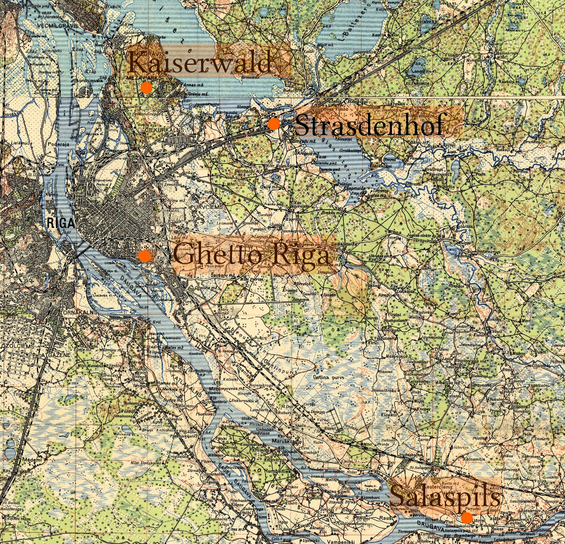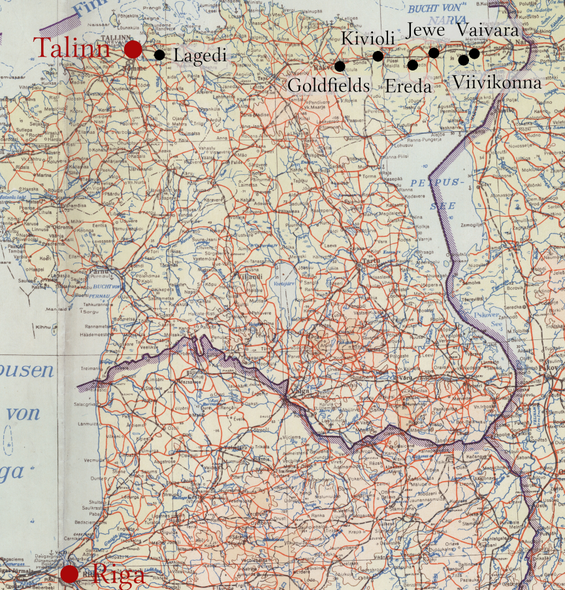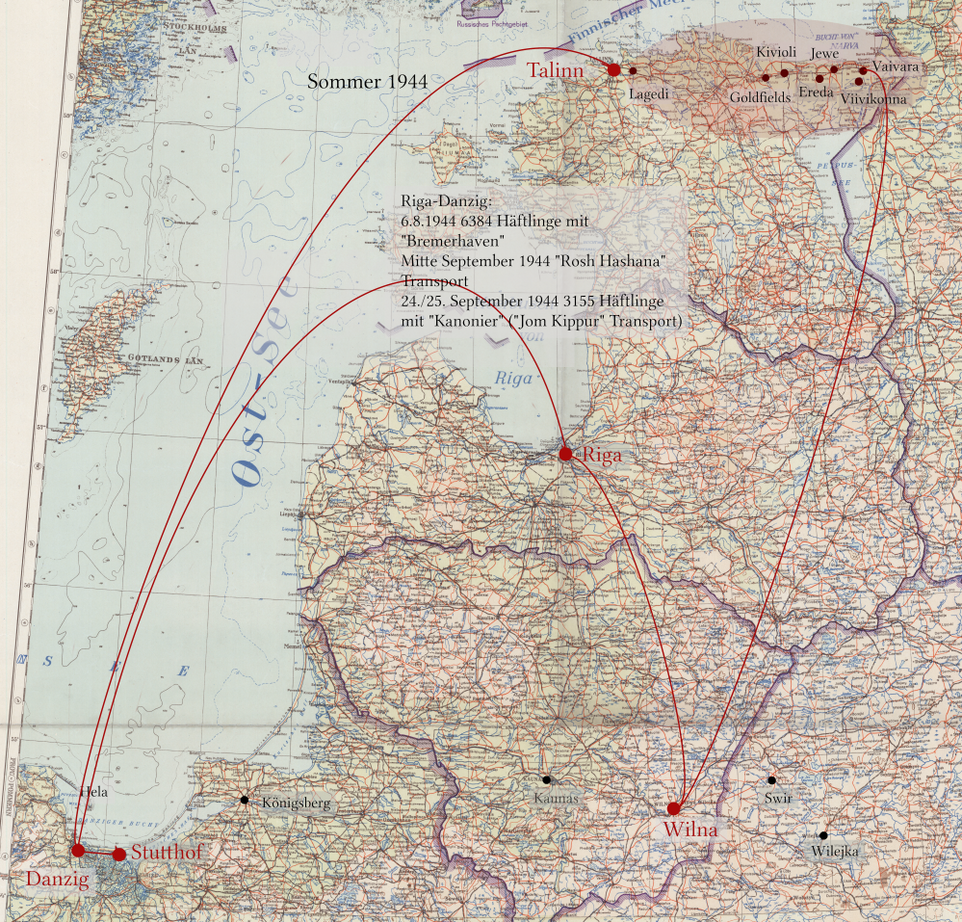Baltic Camps
The following applicants were in the Vaivara concentration camp and its subcamps:
- Vera Aizenberg (September 1943-Late summer 1944 Viivikonna, Ereda, Lagedi),
- Jacob Charmac (November 1943 to September 1944 Viivikonna #3; Ereda; Lagedi),
- Shlomo Charmac ( September 1 1943 to February 1944 Viivikona, February 1944 to July 44 Ereda,),
- Gitel Grilches (1943 Vaivara I, spring 1944 - late summer 1944 Kivioli II),
- Efraim Katz,
- Lea Kochmann (September 1942 to December 1942 ZAL Goldfields, December 1942 to January 1943 Ereda, January 1943 to April 1943 ZAL Jewa, March 1943 to April 1943 ZAL Lagedi, March 1943 to April 1943 ZAL Viivikonna, March 1943 to April 1944 ZAL Vaivara),
- Herrmann Rubinoff,
- Josef Segalowicz (liquidation of Vilnius Ghetto - late summer 1944) ,
- Daniel Shumel (March 1943 to 3 September 1943 Ereda concentration camp).
Vaivara and subcamps
Gitel Grilches
I myself was waggoned in and taken to ZAL Waiwara - the camp was fenced in with barbed wire and guarded by Estonian and German guards. I lived in a wooden barrack together with 75 other women, was given prisoner clothing with the number 1369 and had to do hard forced labour in the forest (cutting down trees, sawing and preparing them for transport). In spring 1944 I was transferred to ZAL KIWIJOLE, where I had to do the same work in the forest under duress under the same conditions as in the previous camp.
From there I was taken by ship to the Stutthof concentration camp in the late summer of 1944.
Source: Affidavit
In Kiwijola she was whipped one day while lying on the table and then thrown off the table so that she was severely injured in the head. When she came to, she had a terrible headache that has not left her since, although there are times when it is lighter.
Source: Expert report
Herrmann Rubinoff
Client and his brother were deported to Estonia on a 4-day railway journey without any food.
Kl. had to carry out electrical work in Kibioli. The first camp leader had treated him well; under his successor they were all severely mistreated. During his one-year stay in Kibioli, many camp inmates were shot.
From Kibioli they were transported again in four-day transports, under the same conditions, to Reval (note: Talinn). There they were loaded onto a boat and travelled via Gdansk to Stutthof.
source: expert opinion
| Subcamps of the Vaivara concentration camp | |
| Location | Kiviõli / Kiviöli |
| Area | General District of Estonia, Reichskommissariat Ostland (1941-1944) |
| Opening | September 1943 (first mention) / 15/09/1943 |
| Closing | The prisoners were "evacuated" to Gdansk via Reval in August 1944. / 31/08/1944 |
| Prisons | |
| Gender | Men |
| Deployment of prisoners at | Baltic Oil Company |
| Type of work | Work in quarry and road construction |
| Source: germany-a-monument.de |
Lea Kochmann
From the ghetto I was driven to the concentration camps in Estonia and from there finally to Stutthof and Bergen-Belsen. Words are not enough to describe all the terrible things that happened to me. I was required to do slave labour under the most miserable conditions. I was beaten every day. I was often starving. We were made to work in all seasons.
Source: affidavit
Josef Segalowicz
When the ghetto in Vilnius was liquidated, I and many other Jews, including Josef Segalowicz, were transferred to the Ereda camp in Estonia. I stayed in this camp for several months; I can no longer remember exactly how many months that was, and from there I was transferred by the Germans, together with Josef Segalowicz, to the camp in Godtfilz. Dr Dworzecki was also transferred to this camp with us. From there I was sent to the Stutthof concentration camp together with Josef Segalowicz[...]
Testimony of Israel Widucki, 1972
Riga concentration camp
| Date | Event | Source |
| 15 March 1943 | Opening. It was quite small in size and only covered an area of 150 metres by 225 metres. Between 2,000 and 3,000 prisoners of both sexes were probably held there. However, it was the organisational centre for the registration and labour deployment of Jews from the ghettos in Latvia and Lithuania - provided they had survived the Holocaust up to that point. As the prisoners were to be exploited through forced labour, 18 satellite camps to the actual concentration camp were also established.</td | ECG, Vol. 1/Part B, p. 1230 ff, riga committee |
| General | There were around 2000 - 3000 prisoners in the camp, which served as a transit camp for the 12-14 satellite camps | |
| 6 August 1944 |
"Bremerhaven" leaves Riga with 6382 prisoners on board for Gdansk |
ECG, Vol. 1/Part B, p 1232 |
| Mid-September 1944 | "Rosh Hashana transport" | |
| 24/25 September | "Yom Kippur Transport": "Kanonier" leaves Riga with 3155 prisoners on board for Danzig | |
| ECG: United States Holocaust Memorial Museum, Encyclopedia of Camps and Ghettos | ||

Rosa Winogrodski
Then we came to the Riga-Kaiserwald concentration camp, where she was already suffering from depression because she couldn't forget everything she had experienced. She was extremely tense, forgetful, had crying fits and convulsions, broke out in a sweat, trembling in her arms and legs, stomach cramps, nausea and was always overtired. I was in the same infirmary with her for abdominal typhus and she had to return to forced labour as soon as she left the infirmary, even though she was only 12-13 years old. I remember a selection in Kaiserwald where she and her mother were beaten so terribly that they were left unconscious.
Source: Witness statement
Alter Feinstein
During forced labour in the Kaiserwald concentration camp, I suffered an accident at work. While I was pushing a tiller of earth in front of me, I was hit by the supervisor, fell down and the tiller coming after me ran over me. I was badly injured on my head, all five fingers of my left hand and my right knee. As the treatment I received left a lot to be desired, I was left with a hole in my right knee and scars on my fingers that can still be seen today.[...] I was 14 years old at the end of the war.
Source: Affidavit

